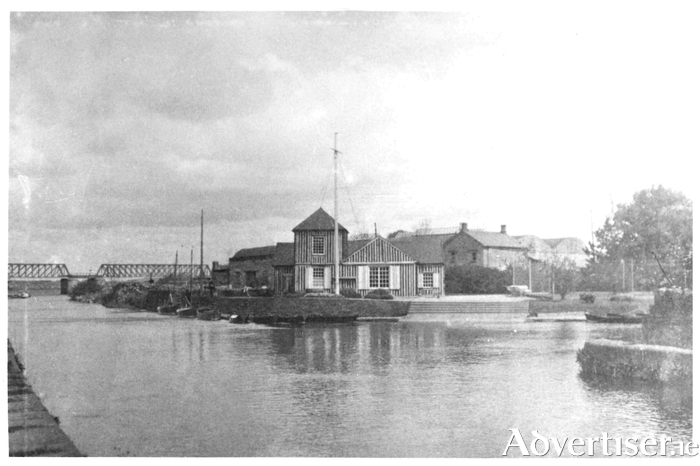Our first illustration today is a drawing by MJ Tighe, architect, Galway, of the proposed new clubhouse for the Royal Galway Yacht Club at the corner of the Gaol River and the Eglinton Canal. The club was founded and received Royal Warrant in 1882. It was established as a social combination to promote sailing and rowing on the bay and lake, and the enjoyment of all the amenities of the Corrib Lake and River. They managed to survive and carry on for some years in difficult circumstances.
The club premises was in a good position, occupying about three roods. It had a long term lease expiring in 2002 at an annual rent of £10. It had recently been enhanced by the provision of a hard court for lawn tennis.
Eventually, the condition of the clubhouse became a source of anxiety to the members, as it was becoming “an interesting study in oils and pitch cleverly supported by a wooden framing”. The storms of the previous 50 years had left it in a very shaky condition. The building was never large enough to house a racing eight and it had been designed without any accommodation for ladies.
The committee decided that any attempt at repair or extension would be useless and they instructed Mr Tighe to draw up a set of plans for a new clubhouse. The work would cost £1,700 and the club already had about £500, partly from subscriptions, partly from ‘prudent management’. So they invited subscriptions to an issue of debentures to raise the balance. Monies were to be sent to the treasurer, WG Lougheed, Eyre Square. The trustees of the club were EK Jackson, Valetta, Galway; A Eraut, the Grammar School, Galway; and RA Tennant, St Mary’s Terrace, Galway. The commodore was Captain RE Palmer and the secretary was AE Sowman.
With the opening of the club in 1882, yachting became a rival sport to rowing on the Corrib. A race to the lake from Steamers Quay was a regular and popular one. The difficulty of passing the great woods of Menlo added zest because many of the boats were becalmed by the shelter of the woods and only Lady Luck could take a hand to provide the ‘cat’s paws’ to get past the castle.
In 1894, Philip O’Gorman, the then secretary of the club, issued a notice concerning the regatta to be held on Galway Bay. There were to be yacht races, hooker races, and rowing races, the latter being under the auspices of the Corrib, Commercial and St Patrick’s rowing clubs. Many of the yachts would have sailed down the canal to the Dún Aengus dock to take part. A race for the Revagh Cup, presented by James W Blake, vice-commodore of the yacht club, was run on the bay, the course being four times around a barque at anchor in the roadstead and the flag-boat moored off the pier. Five boats took part.
The Galway Vindicator in 1896 reported that ‘the flag of the Royal Galway Yacht Club had been carried in a competition on English waters for the first time. The Irish boat, Amulet was manned by amateurs from Ireland. She secured first prizes on the last three occasions and never failed to bring home on her five previous starts’.
The club also held regular races at the Friar’s Cut for club yachts and craft owned by the club members. The course was nine miles starting from the mouth of the lake to Hurney’s Point and then to Angliham and back to the cut. Captain Anketel-Jones of Inishanbo presented a cup for the course, as did Mr Charles A Moon, whose trophy was competed for on Whit Monday, 1905. The boats taking part, and their owners were: Blanche II (CA Moon ), Gracie (TM Kenny ), Eileen (S Anderson ), Blanche I (H Fox ), Violet and Pansy (Royal Galway Yacht Club ). S Anderson was declared the winner.
The club had a very attractive flag in the shape of a pennant which hung from a flagpole at the clubhouse. It was blue with a white St George’s cross and the arms of Galway. The uniform of the club was a blue coat with gilt or bronze buttons and the badge of the club stamped thereon, a waistcoat with similar buttons, blue or white trousers, and a blue cloth cap with a gilt badge bearing the arms of the club. The uniform of the officers differed from the ordinary one in that it had stars worked on the collar.
Many of those involved were from the 17th Lancers, a cavalry regiment who were billeted across the canal. Mr Barnett was the caretaker. One could become a life member on payment of £25. Rule 14 stated: “Only gentlemen members could take out ladies (in boats ) who are members.” Even though a new clubhouse was built, the club went into decline. It was still there in 1937 but gradually its members left. Most joined St Patrick’s Temperance Boat Club which was on the opposite corner of the canal.
Our photograph of the club was taken c1900. The inset shows the club pennant.
Want to receive the Galway Advertiser e-paper straight into your inbox on Thursday mornings? Sign up here and Subscribe to the Tribe!

